From weather forecasts to investment decisions, Netflix recommendations, or credit scoring, predictive analytics plays the role of a crystal ball that blurs future uncertainties by analysing historical data patterns and predicting future outcomes, behaviours, or conditions. From healthcare to banking, manufacturing, marketing, insurance, or logistics, predictive analytics makes it possible to glimpse into the future and navigate the unknown by making data-driven decisions.
“We are surrounded by data, but starved for insights.” – Jay Baer
Predictive analytics in healthcare: what is it?
A branch of advanced analytics, predictive analytics makes use of AI, ML, deep learning, statistical modeling, and data mining to analyze historical and real-time data and allow us to peer in the future. Predictive analytics can be a powerful business tool applicable to a wide range of industries, including healthcare. As SAP summarizes, the predictive analytics process implies various basic steps:
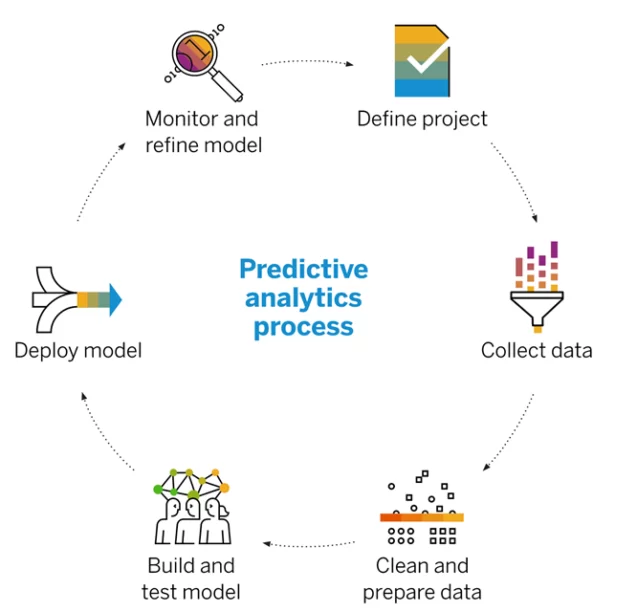
The healthcare analytics industry can be divided into:
- Descriptive analytics: historical patient data is used to gain insights into trends and patterns
- Predictive analytics: forecasting and modelling are used to predict probable future events
- Prescriptive analytics: used ML to bring forward new strategies
Investopedia defines predictive analytics as ‘the use of statistics and modelling techniques to make predictions about future outcomes and performance.’ Even though the possibilities are virtually endless, the use of predictive analytics in healthcare already comes with a series of advantages that cannot be neglected: cost savings, enhanced preventive care by effectively identifying risks, improved patient care, outcomes, and satisfaction, increased diagnosis accuracy, customized treatments, lower health insurance costs, improved operational management, fraud prevention, improved public health surveillance, boosted medical research, enhanced cybersecurity, remote monitoring, etc.
However, the picture is not all rosy and there are many challenges and concerns that need to be addressed: lack of regulation, data safety and integrity concerns, lack of knowledgeable IT professionals, fast-paced technological advancements that require constant adaptability and model updates, etc.
Predictive Analytics: Market Overview
Technological advancements, compounded with the COVID-19 pandemic, the emergence of AI and big data in the healthcare industry, government funding, and the global growing incidences of chronic diseases, have caused the global Healthcare Analytics Market to reach USD 12.3 billion in 2021. According to Global Market Insights, between 2022 and 2030, the market is expected to grow at a CAGR of 11.8%. The predictive analytics segment is expected to grow at a CAGR of 13.2%:
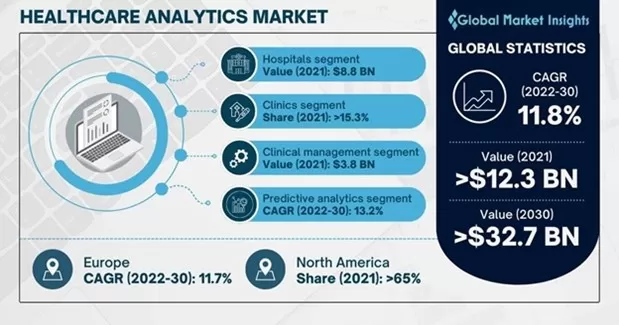
According to ACUMEN Research and Consulting, in 2021, as a result of the rise in financial frauds, it was the financial analytics segment that accounted for the largest industry share, followed by operations management and population health:
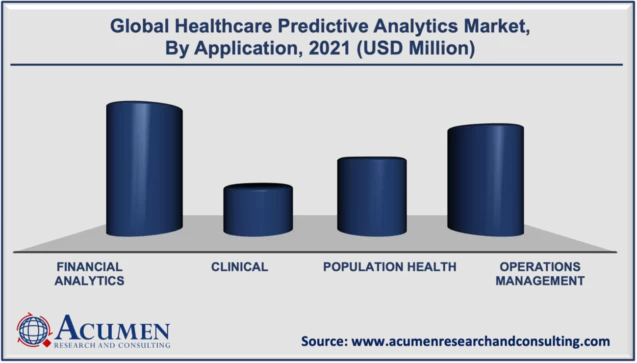
By product, hardware dominates the market:
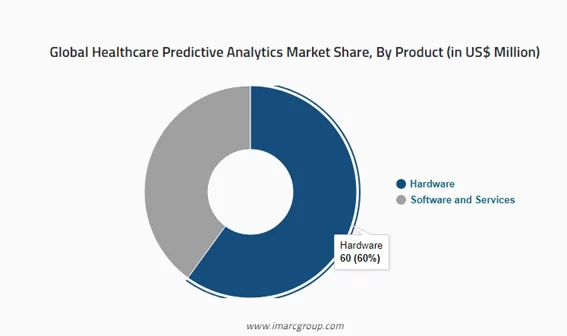
Source: https://www.imarcgroup.com/healthcare-predictive-analytics-market
5 Examples of predictive analytics software
We have already mentioned that the healthcare industry generates massive amounts of data each day. The challenge lies in extracting value from this data for future applications. Since data comes from disparate sets, this would be impossible without cutting-edge hardware and software solutions. With a myriad of current possible uses – and what is yet to come, – healthcare predictive analytics software can not only improve health outcomes but also prevent fraud, improve decision-making, reduce costs, optimize inventory, manage supply chains, enhance cybersecurity, etc. Let’s take a look at some interesting examples:
Healthcare Analytics Software Development by Elinext
Boasting hands-on experience in healthcare solutions development, Elinext develops customised software for care delivery improvement, disease outbreaks prediction, risk detection, decision-making support for doctors, revenue improvement, etc. The company is currently working on innovative tools that will allow doctors to perform real-time analytics, and predictive analytics, thus improving patient outcomes.
SPSS Software (IBM)
This globally-known tech giant has been offering state-of-the-art solutions for over two decades. Flexible, scalable, and intuitive, the SPSS® software package provides healthcare organizations with a series of cutting-edge analytical tools for complex statistical data analysis. Thought out for easy deployment and integration with big data, the package can be used to perform prescriptive, predictive, and descriptive analytics. The package includes various products: SPSS Statistics, SPSS Modeler, SPSS Visualization Designer, SPSS Text Analytics for Surveys, IBM Cloud Pak for Data, or solutions for data management and data documentation.
SAS Visual Data Mining and Machine Learning
This integrated predictive analytics solution offers support throughout the entire predictive modelling life cycle, from data wrangling to deployment. Among its most notable features, we can highlight:
- Bio-medical imaging and computer vision
- Automated insights and interpretability
- Synthetic data generation
- Deep learning with Python
- Natural language generation
- Modern ML algorithms (gradient boosting, decision forests, Bayesian networks, neural networks, etc.)
- API for automated modelling
TIBCO Omni-HealthData® Information Management
Designed to improve patient outcomes, enhance interoperability, boost revenues, and reduce costs, TIBCO offers advanced technologies able to deliver a 360-degree view of all the covered domains:
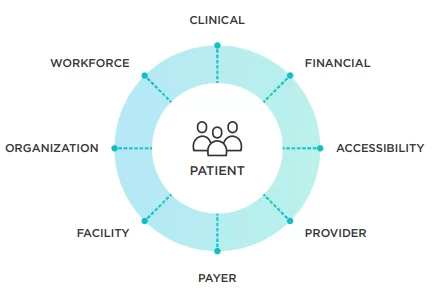
Among its main benefits, we can highlight:
- Enables end-to-end analytics
- Improves interoperability and data integration across a wide variety of systems
- Unifies SDoH with patient data
- Streamlines the revenue cycle process, enhancing profitability
Triskele Labs Cyber Threat Intelligence
The healthcare industry generates massive amounts of sensitive data on a daily basis. In the era of sophisticated cyberattacks, keeping this data safe has turned into a permanent challenge. Triskele Labs offers customised, AI-powered Cyber Threat Intelligence (CTI) solutions that not only ensure real-time protection but can also anticipate threats by using ML to analyse network activities. The company offers multiple defensive, offensive, and advisory solutions: Red Teaming & Attack Simulation, Penetration Testing, Simulated Phishing, Internal and Third-party Risk assessment, etc.
Predictive Analytics in Healthcare: Threats and Perspectives
As Delloitte. was pointing out back in 2019, predictive analytics was already playing a crucial role in epidemiology, operational management, and personalised medicine. This becomes notably relevant in the post-COVID19 era. However, despite the benefits we have already talked about, the rapid adoption of predictive analytics in healthcare is not risk-free. Deloitte. identifies the following sources of risk:
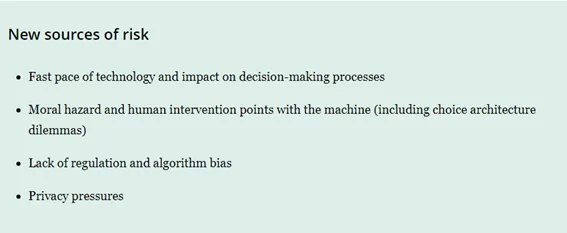
While predictive analytics has already earned its spot in the future of a value-based healthcare industry, ensuring an ethical, secure, and nonbiased foundation for its application in healthcare has become a pressing matter.
Under the present scenario, it becomes obvious that the healthcare facility of the future will need to be intelligent, forward-thinking, and able to integrate traditional services with multiple data-driven, value-based, innovative technologies such as predictive analytics. Predictive analytics will more than likely continue to positively impact decision-making, patient outcomes, customised treatments, risk assessment, supply chain management, overall costs, preventive care plans, public health surveillance, and the list can continue.
To sum up…
Nowadays, the healthcare industry generates vast amounts of highly sensitive and complex data. If we go back to the quote we have started the article with – “We are surrounded by data, but starved for insights.” (Jay Baer), – we realize that this hunger for insights can only be appeased with state-of-the-art predictive analytics software able to process and analyse complex healthcare data and allow us to peer into the future.









